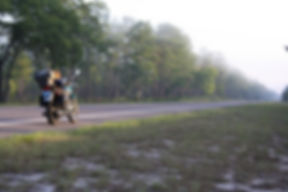LED Auxiliary Lights for the Bonnie
One thing I haven't liked about the new Bonneville is the headlight. It is not super bright and the high beam seems to shoot so much higher than the low that it is hard to adjust. I usually end up spotting owls in the lower branches of trees on high-beam instead of the road.
I have been looking around online for a set of auxiliary lights to help brighten the night and make up for this deficiency. The Bonneville's alternator is not exactly high output so I was looking a for good set of LEDs. I found plenty of options but had pretty much relegated those to a future installation because of the cost of what I found.
I just happened to wander down to a local bike rally in Frostproof last Saturday, about twenty miles south of Lake Wales. I ran across a fellow ADVrider (an adventure riding forum) from the area I was hoping to meet one of these days. What I did not know before was that he sells LED lights (his business is called ADVMonster; you can find a link on our “Motorcycling Links” page). He had a booth set up so we got to chatting about lights. It turns out John has the most affordable sets of lights I have come across anywhere, with a nice discount at the rally (and for fellow ADVrider inmates).
My birthday had been a couple days prior and I just happened to have birthday gift money in my pocket. I had exactly enough for a pair of Model 30 lights. $80 for the set—a far cry less than the typical $140 or higher per light I had seen online, and ten dollars less than his regular price. I didn't hesitate using my gift money to purchase a set.
Here are the specs on these lights, the least expensive they had:
Model 30 LED off road Spot light
Spot Beam
1500 lumens
.85amp@12v
3 LEDs
aluminum housing
Length: 70mm , Diameter 55mm
black durable coating
o-ring sealed housing
one meter wire lead
includes flat mount (stainless) mounting bracket
glass shatter resistant lens
It turned out that by enlarging the mounting hole I could fit these on the same bolt that holds my headlight bucket to the mounting ears. Wiring was pretty simple. I had a wire running to a USB power port on my handlebars for my GPS that was wired so the ignition switch turned it off and on, so I spliced these new lights into that. Both black wires were wired to the ground wire on the USB supply and the switch was connected to the hot wire on one side and the light hot on the other. I mounted the rubber waterproof switch with a little double-sided tape to my windscreen mount on the left so I could operate the lights while riding easily.
I waited until dark then rolled out of the drive for a ride through the evening countryside to put the lights to the test and decide on final aiming angles. The result? I would guess I have twice the light intensity and twice the penetration into the dark. Even though these were the smallest power lights they sold they made a huge difference. You have to be careful to not aim them too high, because if you do when a white retroflective sign (such as a speed limit sign) appears you will almost be blinded by the reflection from the LEDs.
I had been concerned with adding too much electrical equipment to this bike because of the low output alternator and because I may want to add heated grips or clothing later. I wanted to conserve as much power as I could to make that possible. I looked up the electrical specifications in my shop manual for the Bonneville and found out that the alternator was good for 288 watts at 2,000 rpm. I figured up the worst case scenario, where all lights were on with the headlight on high (96.7 watts) and where the alternator was outputting at its 2,000 rpm rating (288 watts). I ended up having about a 191.3 watt (15.94 amps) “overhead,” or surplus. I then added in my USB outlet (10 watts @ 12 volt) and the pair of LED lights (20.4 watts). This gave me a total load of 127.1 watts and a resultant overhead of 160.9 watts—sufficient should I decide to add more accessories. (If you contemplate doing something like this with your bike, you can convert amps to watts easily by multiplying amps by voltage, or watts to amps by dividing watts by voltage.)
As you can see from the first picture, mounting these lights directly to the light bucket ears, while neat, may interfere with other drivers' ability to see one or the other of your turn signals. I remedied this by buying some one inch by one-eighth inch aluminum bar stock, cutting it to a length of about four inches, drilling a hole at each end (one to accommodate the head light bucket bolt and the other for the light bracket), and mounting the lights slightly lower than the turn signals. You can see below the modified installation and that it allows either turn signal to be seen from either side of the bike.

I highly recommend some sort of auxiliary lighting, and these particularly so, for the Bonneville or any other bike ridden extensively at night.
Cheers,
Road Dog
"Ride Your Own Ride"
























